One Hour One Life Forums
a multiplayer game of parenting and civilization building
You are not logged in.
- Topics: Active | Unanswered
#1 Re: Main Forum » Everything About Food (Theorycrafting Guide) » 2019-04-01 00:01:31
Efficiency Plotter now has complete details on the v213 food additions.
In light of the heated debate around Tilling methods, I also made a few other additions for everyone:
Efficiency plots for 1 x Tilling and 2 x Tilling now assume you use the same method for Compost production, rather than the best available. This should give us the truest picture of what farming productivity looks like if your settlement commits to a single approach for all Farmers (as most proponents of each Tilling method have argued for)
Iron consumption between Tilling methods is now shown on the left, so you can quickly compare it for any food
Compost Cycles are now listed as a recipe, so you can see how any food stacks up against the soil economy
All Compost usage calculations have been tweaked to be more accurate (Water and Iron taxes should scale strictly with Soil usage now)
When everyone has a chance to look through the Tilling comparisons, the results might come as quite a surprise! It turns out that 1 x Tilling only typically saves around 5 - 18% on Iron consumption, with less impact any time additional tools are needed (e.g. Shovel for Compost Cycle, Shears for Tortilla Chips). This is dramatically less than the 50% savings that you might intuitively expect when considering how to plant a single crop, but it comes as a direct consequence of the increased Compost usage when you pick that farming strategy.
Does that change where you stand on the Tilling debate or reinforce your thoughts about which is best?
#2 Re: Main Forum » War on stone hoes » 2019-03-29 20:04:01
If you've had a chance to explore the efficiency plotter from the Everything About Food thread, it points out some interesting conditions on how to use Stone Hoes. They may be a bit different than you'd intuitively expect!
2 Fertile Soil: 1 x Tilling these tiles with a (domestic) Stone Hoe gives the worst Food per Soil of any farming strategy, so you should never use them that way if you can avoid it. If you're mentally committed to the 1 x Tilling meta, that means you'll never want to use a Stone Hoe.
Hardened Rows: 1 x Tilling for Hardened Rows with a Stone Hoe uses more Compost but less Iron than a Steel Hoe, so it might be worthwhile if you're facing a significant Iron shortage. Foraged tools (either Skewers or wild Milkweed) give the best of both worlds, if you have them available.
1 Fertile Soil: 2 x Tilling with a Stone Hoe surprisingly uses both less Compost and less Iron than a Steel Hoe on 1 x Tilling. That means any craft which relies on crops that don't leave Hardened Rows (specifically Wheat, Sugar Cane, or Milkweed) performs substantially better across the board when planted with a Stone Hoe.
As you might have noticed already, that also suggests the Compost Cycle and all forms of Pie are much more efficient with Stone Hoe usage! Your entire food production chain receives a nearly 10% output boost if you grow the cycle crops that way (after accounting for Milkweed growing costs). That bumps up to 15% output boost if you can forage for Skewers / wild Milkweed to use instead.
While growing domestic Milkweed for Stone Hoes removes the capacity limitations of foraging, it does transfer a substantial amount of tool-making labor from the Smithy / Iron Miner over to the Farming folks. Its efficiency also depends on Farmers using 2 x Tilling consistently (especially on the Milkweed), otherwise it's about the same as using Steel Hoes.
Given how different that is from the current farming meta, I'd be really curious to see how a few villages fare when following the max efficiency farming strategies. If domestic Milkweed production flourished enough, I suspect a lot of the nervousness around Rope usage would evaporate within a few generations. Personally, though, I probably wouldn't favor it as a new farming meta since Iron consumption feels pretty trivial once you unlock Horse Carts for further exploration.
#3 Re: Main Forum » Everything About Food (Theorycrafting Guide) » 2019-03-28 12:06:09
Now, for the neat theorycrafting stuff!
On the same vein, it seems like most compound foods (except wheat-only foods) should have a replant strategy.
For foods where only a few of the ingredients can be replanted, the efficiency plots use the best choice between replanting or 1XT / 2XT for each crop. In practice, that basically assumes you'll replant any crop that can be (since it's always better).
All in all, its neat to see a different viewpoint and I could use some help understanding the way you model compost.
This approach to modeling Compost uses the real-world math for manufacturing productivity, so you can basically describe it as a comparison between the production effort vs. useful results we receive from each complete cycle through the soil economy. Since that number is below 100%, it means that a Basket of Soil taken from a Compost Pile actually represents less food than an identical Basket of Soil taken from a Fertile Soil Pit when planting the same crops. In each case, this difference should be exactly 1/7th of the useful soil that was lost in creating that Compost Pile.
However, figuring out that 'exact' lost amount could actually be a really long and messy calculation:
If we assume a rounded 20% of the soil in each Compost Pile is lost on creating the next one, then whenever a player collects a Basket of Soil from it we effectively lose 0.6 Fertile Soil in food potential
But... when that 0.6 Fertile Soil was taken from some Compost Pile, we lost another 0.12 Fertile Soil in food potential
And when we took that from some Compost Pile, we lost another 0.024 Fertile Soil in food potential
And when we took it again, another 0.0048 Fertile Soil in food potential
And again, another 0.00096 Fertile Soil in food potential
And again...
So exactly how much Fertile Soil did we lose on the way to that 1 Basket of Soil? You could keep counting up to an infinite number of ever-smaller soil piles if you had enough patience! Luckily, the math for doing that is actually sillypants easy:
That's where the soil cost multiplier comes from, since it's using this as a shortcut calculation for "How much Fertile Soil was lost if all the soil came from Compost?" Basically an extended version of what you suggested.
The iterations for the Compost Cycle spreadsheet follow essentially the same math, but breaking it into stages: "How much is lost if it all came from 1st generation Compost Piles?" "What about 2nd generation?" "...3rd generation?" "...4th generation?" "...1,000th generation?" What we find is that within a few generations, the answers level out to effectively the same soil efficiency no matter how far out you go.
Here's how that process looks, from a new tab I added to the efficiency plotter (called Compost Progress):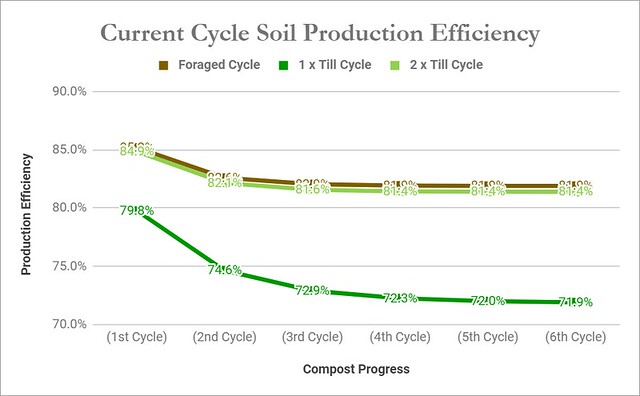
Where all this becomes important is the productivity penalty that it places on every subsequent stage of farming and food-making. When you carry 100 Baskets of Soil from the Compost Pile over to growing areas, 20 - 30 of them will produce no food for the settlement. Each minute spent tilling and farming that soil produces no food. Each person busy with processing it produces no food. Each Hoe you craft for it produces no food. (I'm over-simplifying a little bit here for rhetorical effect)
If we convert all that into an efficiency cost for food production, we get the Compost strategies shown on the plotter along with what (should be) the real food productivity that players experience when relying entirely on the Compost cycle.
What are your thoughts on displaying the the mutton pie food and skin bonus with the compost strategy?
Maybe also the byproducts straw/dung from wheat products/cooked mutton?
From an efficiency perspective, the Mutton Pie and Wool/Sheepskin production is actually the same everywhere. That's why it's left out in the calculations. As long as you use 100% of the surplus soil from each Compost cycle, anything you grow (even non-food) will give an extra 240 Food and 1 Wool/Sheepskin.
The one exception is Mutton Pie itself, since it can't be produced without (technically) starting a new Compost cycle. The efficiency calculations for it basically assume that you've thrown out all the soil from its cycle, generally by allowing Sheep Dung to pile up near the sheep pen that never gets used in your generation.
If the cycle gets completed eventually, that Mutton Pie becomes part of the "soil economy" and doesn't affect the ~17.2 surplus soil we're trying to optimize for food production anymore. The same exclusion also probably applies for any of the 'free' outputs you might decide to make:
Mutton Pie (+240 Food)
Cooked Mutton / Baked Bread (+112 Food)
Cooked Mutton / Rabbit Pie (+272 Food)
Cooked Mutton / Wild Bean Burrito (+162 Food)
But this might even be worth its own discussion if we're breaking open the possibility for alternative Compost cycles.
#4 Re: Main Forum » Everything About Food (Theorycrafting Guide) » 2019-03-28 11:10:04
I've finished making some big updates to the Efficiency Plotter based on everyone's suggestions so far!
Forage tactics for farming tools now have their own strategy section (includes both Skewers and Stone Hoes from wild Milkweed)
Numerous fixes for seed costs, compost cycle, and Potato formulas (thanks Betame!)
Took out a shortcut in the compost math to make it more precise
Added Ice Cream to the food options for the upcoming release
Older versions of each sheet are still available and renamed to "(1.0)" for anyone who wants to compare the changes.
#5 Re: Main Forum » I tried to have a no gooseberry town. » 2019-03-24 02:29:59
I, like many, am a fan of Ferna's infographics, and how they reason about food in general.
I'm just wondering where the numbers are coming from, since they differ from what I'd reasoned. And the numbers NoTruePunk had added on the wiki don't agree with either of us! It's unnerving for me that we've all come up with different answers to the same numerical question.
The Everything About Food thread is basically my answer to this question! When putting together the efficiency plotter spreadsheet for the second section, I found that essentially all of the differences come from which farming strategy we applied in each set of math. The goal with this was to put the math for every strategy in one place so we could compare the different assumptions.
Looking at the efficiency plots, I've started to have some doubts about the 2 Soil x 1 Tilling for Steel Hoes that became popular after Iron spawn rates were nerfed. That farming strategy actually seems like the worst of all worlds: soil efficiency plummets for most foods, your iron efficiency doesn't improve much, and you end up using more water and Shovels running Compost cycles to keep up with food demand. What are your thoughts on the appeal of sticking with that vs. optimizing around a different strategy?
#6 Re: Main Forum » Everything About Food (Theorycrafting Guide) » 2019-03-24 01:44:13
Did your list in 4 consider tilling or shovel usage? I think this could hurt berries and mangos, since they have no continuous tilling cost as their major advantage.
Every food on the list (other than Compost cycle crops) is required to use soil, water, and iron more efficiently than a Gooseberry diet under the best farming strategy for that resource, which turns out to be a pretty reasonable standard with most foods. Generally, there's no single-best farming strategy that delivers the top efficiency on every one of those resources at once though.
Mango Slices are marked as an 'Underpowered Food' since they don't meet the standard on water usage compared to Gooseberry Bushes (even regrowth is an ~60% drop in Food per Water). They also take at least 2.5 hours to start producing just 144 f/hr., so there's currently not much incentive to grow them for survival purposes.
If you're still curious, you can look at all the comparisons for yourself on this section of the efficiency plotter: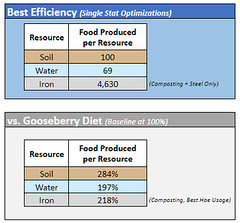
Carrots shouldnt score so much better than berries overall just because of production speed (i mix both early game because of speed + stability).
It looks like they snuck into the graphics with a different rating than intended! (will be fixed shortly)
Carrots are just a little higher (B food) than Gooseberries (C food) since they have similar efficiency, but you can start churning out ~525 f/hr. in as quickly as 4 minutes when there's a berry famine. It's enough of a stopgap food supply to save a lot of children from starving, but too work-intensive to provide a staple diet for the entire village.
#7 Re: Main Forum » Everything About Food (Theorycrafting Guide) » 2019-03-23 22:59:25
This is so cool. I quibble about the stone hoe, though. It's possible to send people foraging for steaks and use those to save the string for... well for everything.
The farming strategies for Stone Hoe assume that you grow the 4 Milkweed domestically so you won't eventually deplete all availability for it. With that approach, planting with 1 Soil x 2 Tilling turns out to be the cheapest per Tilling use. Domestic Saplings are left out since they produce the Weak Skewer variant that breaks instantly if you try to Till with it (no net Tilling uses).
Foraging is basically free from an efficiency perspective, so any Skewers or Milkweed you gather from the wild will match Steel Hoes for Food per Soil and Water per Soil, but have ~30% better Food per Iron than (domestic) Stone Hoes in the same situation: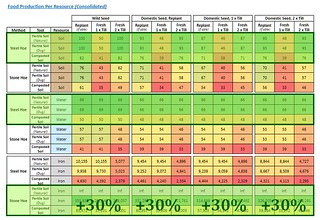
While villages don't grow Milkweed often now, if we're keen on maximizing Iron efficiency perhaps we should consider it as a large-scale practice? It would certainly transform the Rope availability for other tech if we did! (Bows, Buckets, Hand Carts, ...)
#8 Main Forum » Everything About Food (Theorycrafting Guide) » 2019-03-23 17:58:03
- Ferna
- Replies: 25
Farming and food production are central to the survival gameplay of OHOL, but due to the sheer number of options available it’s often difficult even for the most experienced players to reach a consensus on basic recommendations for new players. This results in piles of conflicting information for everyone.
To resolve that, this guide is aimed at laying out the farming and food options—in their entirety—so even moderately experienced players will feel ready to grasp the best food production strategies. With any luck, we might even agree on the same ones!
Topics
1. Why care about food?
2. Finding efficient farming strategies
3. Maximizing food output from village workspaces
4. Advancing along the food technology tree
5. Taking advantage of hunger reduction
1. Why care about food?
The obvious quip might be “so you don’t starve”, but that’s missing the real question here. One of the earliest aspects of OHOL that most new players are taught is that farming and food production depends on a steady supply of fresh soil and water—without which, everyone dies. Soon after, they'll learn to fetch soil from a Compost pile and water to refresh the Gooseberry Bushes the village depends on for Sheep.
So the real question for us should be, “If Sheep give us food and Compost, why do we bother producing anything except Mutton Pie?” To answer that properly, we need to look at the underlying food economy in OHOL: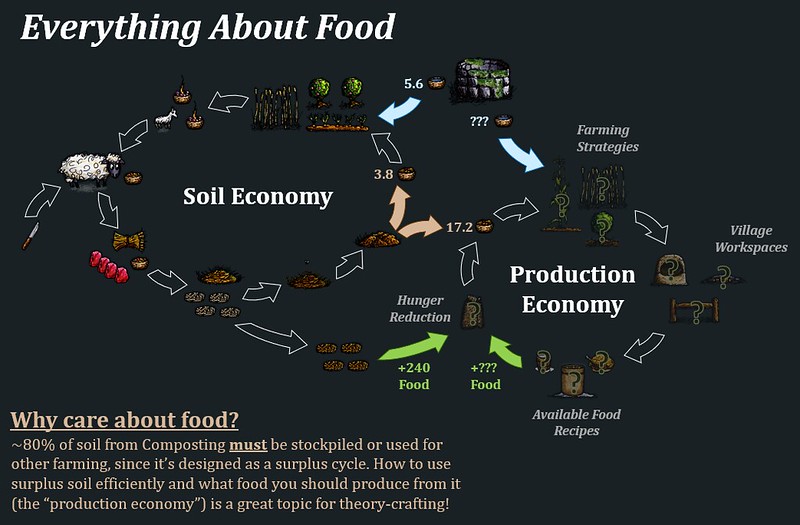
In one sense, it is entirely possible to survive on Mutton Pies alone while your village simply piles up ~80% of its soil in a corner never to be used. This often happens in ancient ruins, where the sheer volume of food that past generations created dwarfs the small number of current inhabitants. At that point, survival simply stops being a significant gameplay element for a few generations.
For every other camp, village, and city you can find, generating a large enough food economy to feed your entire settlement is a difficult, time-consuming challenge. While the soil economy remains critical, it's both (1) Vulnerable to coordination failures at multiple steps and (2) Quite slow to recover, with up to 15 minutes needed to restart it whenever a berry famine occurs. With everyone’s survival on the line, it's a risky gambit to rely on just ~20% of the available food economy to keep everyone fed!
So the obvious choice (and a consistently well-rewarded one) is to build out a diverse food economy and attempt to produce as much food as you can from the ~80% surplus soil available in each Compost cycle.
2. Finding efficient farming strategies
The first approach we'll consider for optimizing food is to determine how much food can you get from each important resource (soil, water, or iron) before they run out. Every resource comes at a cost of player time and effort, so what gives the best possible payoff in a production economy?
Fortunately, OHOL offers an enormous number of alternatives compared to most games for how you can obtain those resources, plant and grow each crop, then convert the harvest into final foods. This presents an enormous challenge for theorycrafting, though, and players can (and often do) spend entire threads just talking about how to optimize one food made from one crop without ever coming to the same results.
So instead of telling you about food efficiency, I’d like to show you!
One Hour One Life - Everything Food Efficiency Plotter
This efficiency plotter covers all the foods currently in OHOL, along with all the possible farming methods you could use to produce them. I encourage everyone to play around with it, since the goal is to help you quickly visualize all the different performance levels without doing a lick of extra math!
Now as you might notice after exploring it for a few minutes, the amount of food that villages can produce for each unit of soil, water, and iron changes dramatically depending on how exactly they plan to plant and grow it. And as you might expect, there's no single-best farming method that optimizes for every resource at the same time.
So lengthy threads about which farming strategies to chase, in order to optimize this or that resource, are sure to continue for a very long time. Should it be soil to reduce famines? Or water to reduce early farming pressure? Or iron to make cities last as long as possible?
Whatever your side, I can offer a few tips based on these efficiency plots:
If you’re aiming for the most Food per Soil, you should be permissive about 2 x Tilling with Steel Hoes or focus heavily on crops that always leave Hardened Rows (such as Corn, Beans, etc.)
If you’re aiming for the most Food per Water, planting close to water sources and upgrading them along the technology tree will probably pay off quicker than trying to conserve usage
If you’re aiming for the most Food per Iron, relying on Stone Hoes is dramatically (often more than 10 - 100x) better than any use of Steel Hoes. Bringing in soil with a Horse Cart is also a great solution to any temporary shortfalls in Iron supply
3. Maximizing food output from village workspaces
A second approach to food optimization (and my personal favorite) is to treat any settlement more like a collection of workshops. Given how much workspace you have in each, how quickly can you produce food in the time your players have available for cooking?
In contrast to farming activities, which tend to meander comfortably around the outskirts of settlements, cooking requires a ton of free space, a variety of different tools and ingredients, and often-frantic activity inside buildings or other crowded spaces near the center of town. It’s entirely reasonable under some circumstances to worry about whether they can cook all the food your growing village needs. If a berry famine strikes, can your workspaces handle the rush of hungry people battering down their doors?
That's a pretty difficult question. Trying to precisely simulate how this could play out in any settlement is messy enough to make a mathematician spit milk out of their nose, and I suspect it wouldn’t be all that helpful for us to look at every possible village arrangement and cooking strategy.
So instead, we'll simplify! If you boil down the essence of each cooking sequence, I think we can pick out 5 major factors that have the largest influence on workspace production:
Food Output - How much food you receive from each batch
Difficulty - How many distinct ingredients, number of steps, or player actions you need to make it
Prep Time - How long in game time you have to wait to grow and cook the ingredients with full player attention
Marginal Gain - Does cooking result in more efficient soil, water, and iron usage than the default diet (munching Gooseberries)?
Diminishing Returns - Does continuing down a longer recipe chain (or with more difficult steps) pay off well?
Based on those factors, I've put together a complete Food Tier List for you that captures (to a rough approximation) how quickly each recipe can produce food and what workspace conditions you should meet before starting it: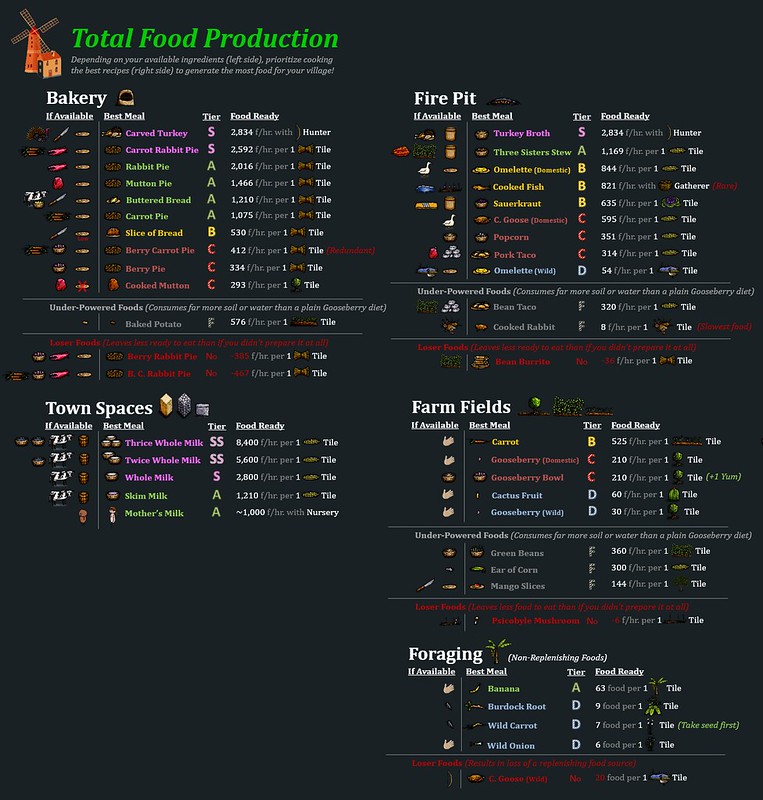
Cautionary Note: As with any attempt at ranking stuff, there's some subjectivity and wiggle room in the grading. I'd like to present these more as friendly suggestions for how to maximize your time and effort in each workspace, rather than a casus belli for murdering new players if they don't happen to follow it. It's also worth sharing with us any tidbits that you think make specific foods better, or worse, than their numbers would suggest!
Each of the Food Tiers represent recipes that have largely similar performance across the factors we mentioned earlier:
SS foods - Ridiculously good, with food production soaring past 5,000 food per hour (f/hr.). Each farming plot you put toward these is equivalent to planting 30 - 50 Gooseberry Bushes.
S foods - A balanced ideal, providing a quick solution to any berry famine with ~2,500 f/hr., but often requiring you to meet complex conditions first. Since they're also up to ~15x better Food per Soil than Gooseberry Bushes, it's always worth going out of your way to prepare them.
A foods - Provide a solid staple diet for any settlement. With ~1,000 f/hr. production it's necessary to devote multiple farm plots to each ingredient to ensure a steady food supply, but the efficiency is much better than Gooseberries.
B foods - Work-intensive for their payoff of ~500 f/hr. The recipes are difficult enough that it will mostly be experienced players handling them, but they're a reliable stopgap if famine strikes.
C foods - Struggle with low production rates of ~200 - 300 f./hr, so they require enormous amounts of farmland to feed a settlement. Other than Gooseberries themselves, most are ~2x as efficient as letting players snack on bushes.
D foods - While forageables can be amazing for efficiency, at ~60 f./hr (or no regrowth at all) you can't use them to support a village. However, they're always a popular snack for experienced players away from town.
Each of the foods and its ranking are available in the efficiency plotter if you’re interested in taking a closer look at how they measure up from a different perspective.
4. Advancing along the food technology tree
A third approach to food optimization aligns more closely with thinking about overall technology advancements. As additional crafting steps become available, what recipes are worth switching to given the ingredients you already have on-hand? And when is it worth pausing cooking to push an infrastructure activity (like Building, Platesmithing, or Smithing) instead?
As players become more experienced across a variety of key professions, this becomes a significant aspect of planning out how to best use your available playtime each life. If the village's resources run out or a berry famine strikes before you've made important technology steps, it can also have deadly consequences for children and new players in your lineage.
Luckily, step-wise food production is relatively simple to optimize because the technology tree for every settlement is exactly the same. Once you know how the foods and their technology requirements are related, the choice between whether to cook or tech up comes easily: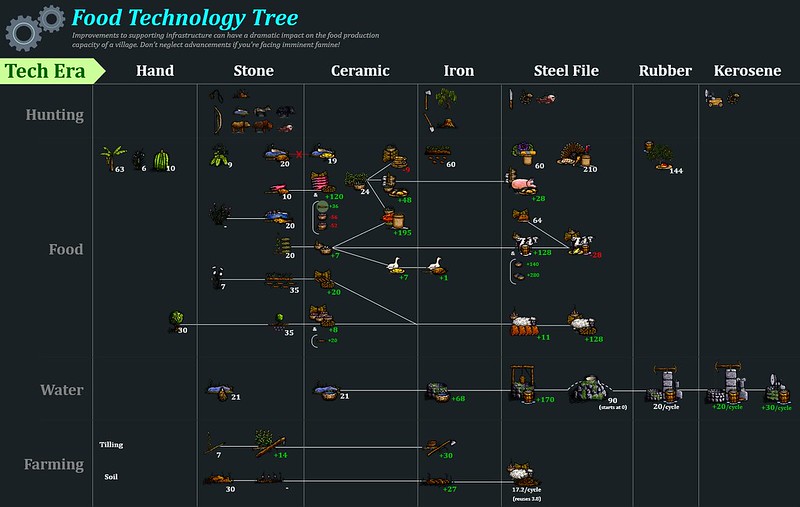
You might notice that several recipes have “negative food” values. This indicates that the pip value of the food actually decreased because you unlocked the recipe or used it. This creates a very challenging situation for players, because we tend to assume that cooking always produces food!
While there are some circumstances that can make these foods worthwhile (for example, teaching children to drink Skim Milk), it puts a serious dent in any consideration of their production rates and soil, water, or iron efficiency. Ideally, these foods will be reviewed by Jason for potential fixes / improvements at some point.
Until then, most of these have been isolated as 'Loser Foods' in the Food Tier List so you can spot them as potential pitfalls. It's entirely up to your judgment (and curiosity) for whether you'd like to try crafting them anyways, but do be careful of anyone who comes near you with a knife!
5. Taking advantage of hunger reduction
The fourth, and final, approach to food optimization is considering mechanics which can reduce how much players need to eat rather than attempting to boost food output or efficiency. Surprisingly, it’s an approach that also tends to be self-defeating: most methods of reducing hunger also boost fertility, so villages which manage to keep hunger low will invariably have more babies and a rapidly-growing population to eat up the difference!
While that often sparks heated discussions of whether hunger reduction has merit for villages, the choice on whether to pursue it depends entirely on personal game mechanics that players (once they're no longer babies) largely have to manage for themselves. Given that, we'll sidestep all of the "greater good" questions surrounding hunger reduction to simply consider whether it has worthwhile personal benefits if you optimize it.
Yum Chaining
At this point you might be curious, “Why wasn’t Yum mentioned way earlier?” That’s largely because Yum Chaining is a function of player history and not the foods you consume. While we can discuss food sets (such as “6 different foods”), the game doesn't concern itself with which ones they are or what order you ate them in order to obtain your Yum bonus.
While it takes a great deal of food knowledge to reach Perfect Yum Chains (which can be anywhere from 12x – 29x), doing so provides around a 40 – 60% reduction in your Total Food per Life requirement. If you succeed, it pays off spectacularly in your later years when you can switch from eating at ~90 second intervals (no Yum Chain) to comfortable stretches of 5 – 6 minutes between meals that can even hyper-extend to 13 minutes at ideal temperatures (fully-clothed near a fire).
The most difficult part, in practice, is becoming familiar with the pip values and starting ages when you can move up to better foods. Any interruptions or overeating can drop you to only modest benefits from Yum Chaining, so it's a bit of a gamble even if you take it seriously.
But if you're the gambling type, then this is for you: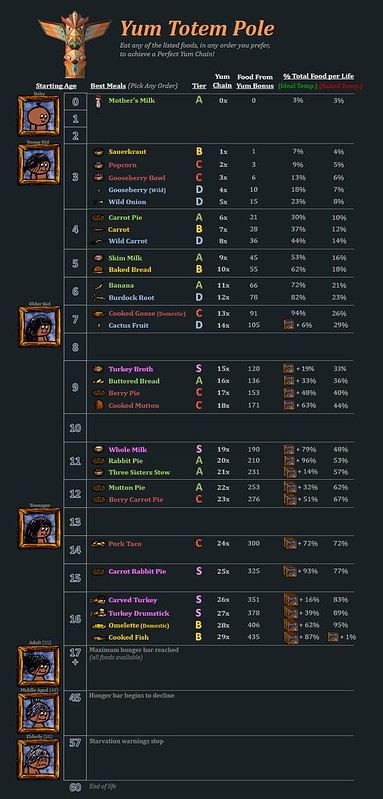
Despite the earlier assurance that we'd sidestep "greater good" questions, it's worth noting that Perfect Yum Chains are entirely possible without resorting to any foods that are less efficient than Gooseberry snacking. That means your overall diet, even with a partial Yum Chain, is going to be quite a bit better than any new player in the village. So this receives a thumbs-up for efficiency!
It’s entirely up to you on whether to pursue Yum Chaining, though. Since it's a personal game mechanic, it's quite hard to notice whether any one player relies on it or not in the overall food economy.
Temperature Management
After Gooseberry tending, temperature management is one of the very first things that most new players learn about in OHOL. While this has seen some major alterations in recent patches, it remains a potent method of hunger reduction for players of all experience levels.
Past work by temperature theorycrafters, suggests that reaching ideal temperatures can bring your Total Food per Life requirement down by as much as 80% over a lifetime. Conversely, mismanaging temperature (such as hanging out in Desert fully-clothed or hugging Mosquitos) can also bring it down greatly by turning you into a toasty pile of bones.
Since temperature management pays off immediately and consistently, it's worth paying close attention to it even if you're not the gambling type. Under the current ruleset, the tips for temperature management are pretty simple:
Clothing - Most types provide high % Insulation, which is indispensable now. Load up with as much as you can wear! Aprons provide no insulation, so it's a tradeoff for extra carrying space.
Fires - When young (baby) or elderly, hanging out ~0-1 tiles from a fire achieves the best temperatures. Natural tiles can no longer bring you to ideal temperatures (like pre-patch Jungle or Desert edges).
Overheating - Avoid spending any substantial time in Jungles or Deserts. They're currently inhospitable enough that only highly-experienced players should pursue activities there (like Oil Drilling).
Although players can only manage temperatures for themselves, it's worthwhile to teach babies and new players about it whenever there's an opportunity. This can improve survival rates for children dramatically, even though there aren't any "neat tricks" for experienced players to master at the moment.
That’s all the topics for this guide! I’m looking forward to discussing it with everyone.
End
Edit: Corrected Carrots to B rank in graphics
#9 Re: Main Forum » I tried to have a no gooseberry town. » 2019-03-18 01:01:09
I'd push popcorn as a good starter food for a berry-free village. Carrots in short-term, then popcorn to reduce the cost. Longterm, it is out-performed by other options (especially milk), but I would continue to use it as "baby food" until other options were viable for mass-production. Mostly because corn is cheap and easy, so you should always have a decent amount available.
I don't think you've given the food economy complete enough consideration here. Corn is a long replacement-time crop (over 8 minutes) that's providing the foundation for your entire Stew and Milk food supply. If well-meaning newbies poach all of your Shucked Corn while it's drying or your Dried Corn to make snacks, there's a nearly 8 minute delay before you can produce any further food -- so that almost immediately rules it out for this village.
Your initial suggestion of Carrots as a short-term food source was more on the mark, I think, and supports a better economic progression to Bread / Carrot Pie as the secondary food chain. Importantly, Rabbit Pie production can never match farming capacity long-term (due to 1 hour respawn times), so there's always going to be room to fit more Wheat-based cooking if you want to keep your Bakery busy. Both of these foods also beat Popcorn by +40% food per Soil/Water and +600 food per Iron, so there isn't an efficiency argument that favors Popcorn either.
Lastly, and the same as any production process, bottlenecks are what drive the overall performance of the system. While I get that Corn alone probably appeals to you as an 'elegantly simple' approach, it's nowhere near as trustworthy as a mixed food economy across Corn / Carrot / Wheat. Even in a case where we're relying on Gooseberry production as well, poaching of Corn supplies is a major nuisance for Stew and Milk producers because you lose nearly 1/6th of a working life if there's a shortage. We should be practical here and go by the numbers here, even if the result seems less than neat and tidy.
#10 Re: Main Forum » I tried to have a no gooseberry town. » 2019-03-17 21:57:37
If you want to be really hardcore, skip sheep and go straight to the cow. Make as many buckets as possible and switch to a popcorn and milk diet. Make horse carts and gather wild dirt for your corn farms. Look down scornfully on any village that relies on compost to survive.
Cows and Sheep become available at the same time, but it's arguably easier to unlock Cows since they're on the same tech path as Deep Wells (unmissable) and only need 2 - 4 tiles of pen space for even the largest villages. With an experienced milker, farming 1 Corn plot can be enough to support ~10 - 20 villagers for their entire lives.
However, you're probably putting too much emphasis on Popcorn here. It's not that good by any measure except the low age threshold (which Mother's Milk already covers almost for free), so it's a bit misleading to pull it out as your sole example. For children Age 4 - 5, it's generally outperformed by Skim Milk, Bread, Carrot Pie, or Sauerkraut regardless of whether you have Gooseberries growing.
#11 Re: Main Forum » I tried to have a no gooseberry town. » 2019-03-17 19:39:14
We died off, not a good idea. Needed food for kids in-between stews. We had to make stew so quickly.
For children, there's actually several early-tech foods that beat out Gooseberries by a significant margin:
Cooked Carrot Pie (7 pips x 4 meals)
No waste if Age 4+
80% more food per Soil/Water
6 min. to start production
Popcorn (3 pips x 4 meals)
Never wastes pips
20% more food per Soil/Water
8 min. to start production
Raw Carrots (7 pips x 1 meal)
No waste if Age 4+
Equal food per Soil/Water
4 min. to start production
So from a food supply perspective, there's definitely no reason you must fail without Gooseberries. In fact, you'd probably be better off getting food up and running 4 - 6 minutes earlier!
However, Gooseberries are quite helpful if you want to task your newbies with Farming upkeep (since there's no tilling, seeding, etc.) while the experienced players focus on advancing tech eras. You should also plan to make several Hoes early on if going for other crops, since tool usage is significantly heavier for anything except Cows.
#12 Re: Main Forum » Tacos and Burritos » 2019-03-15 01:29:54
But you can't have a stack of pies on one plate and have 6 different people each take one and put them in their pack for later.
Bread. You go from 8 slices (really 12) down to 6 when making dough into Burritos.
If there was an outstanding aspect to Burritos that balanced out their food loss, I'd definitely mention it. But I never found one across all the metrics I could think up for testing (net food per craft, food production speed, portability, Yum potential, storage density, ideal age ranges, soil efficiency, water efficiency, and iron efficiency).
Now, going into some heavier math for people who like that stuff:
You need interval numbers or fuzzy numbers to have accuracy here (and for anyone who doesn't know fuzzy numbers are a thing... see here for example: http://www.cb.uu.se/~joakim/course/fuzz … /L9_4.pdf).
This isn't an appropriate application for fuzzy numbers. Yum Chains are not a property of food items (they're a function of player proximity and history), so you can't produce a stationary probability curve (which we need) under general conditions if you approach it that way.
Luckily, there's a different way to approach Yum Values that's pretty darn easy: it's just another factor that discounts from the Total Food Per Life requirement for each player, similar to how we handle temperature and clothing. A player who pulls off a perfect Yum Chain can reach up to ~60% total discount, while perfect temperature and clothing can be as high as ~75% total discount. Other factors, like overeating, can also be handled as negative discounts.
When comparing food production, there's no particular reason to worry about discounts. Why? Well, for any menu that supports a given Yum Chain (say, 20 different foods), the relative performance of food sources within the menu will always be the same with changes only occurring on what foods are included / excluded based on varying player conditions. Conveniently, if you also rank the performance of food sources without Yum, it will give you a nearly identical "Yum totem pole" as every Yum Chain menu for the same conditions. So you can just ignore it!
That's why I'd definitely recommend this as the best math approach for the topic.
#13 Re: Main Forum » Tacos and Burritos » 2019-03-14 23:16:16
I think most of the reason making burritos and tacos make clutter is not enough people know what you are doing and there aren't really established patters for how such stations should be laid out...
Perhaps the move is to find a town with a long road to nowhere (but a nowhere with a pond for water) and make a taco outpost town at the end of the road.
A main feature of Fire Pit cooking is that the workspaces can be packed up and moved easily, so I don't think it's especially helpful to think about it as a fixed structure like the Bakery. Rather than trying to find a "perfect" site for it, you can produce these kinds of foods the fastest by splitting them up into stages:
Gather Limestone and stack it near the Smithy
Construct a simple Limestone Station when you're ready to process it:
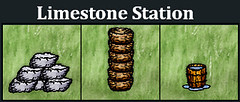
(Often the Smith or Builder will even start processing it for you, no questions asked!)
Bring your Slaked Lime somewhere near the Bakery
Set up an ideal Fire Pit layout for the task (less movement is better):
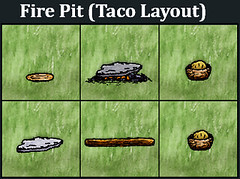
Finally, hop into the Bakery to prepare your Carnitas and/or Beans then combine to finish
Pork Tacos and Bean Tacos are still very step-intensive crafts, though, so it's difficult to get food production rates that are competitive with other Fire Pit recipes unless you have a lot of support from other professions. That's another reason why Tacos and Burritos are pretty underpowered right now.
#14 Re: Main Forum » Tacos and Burritos » 2019-03-14 08:05:20
If you are desperate on pies you can slap dem pies up with carrots, rabbits and berries.
Avoid mixing Gooseberries into the same pies as Rabbit, though! Rabbit Berry Pie and Rabbit Berry Carrot Pie are the other major cases where you end up with less food than you started with.
Among the other types, Carrot Pies can be a great food for kids since the lower pip count means they can start eating it as early as Age 4 without wasting any. It's also ~2x better on Soil/Water than having kids eat Gooseberries and much faster than waiting for Bushes to refresh. However, the lack of visual differences between pie types can often make it frustrating for bakers to keep track of what needs restocking.
#15 Re: Main Forum » Tacos and Burritos » 2019-03-14 07:48:03
This is just a small question... would you consider making Tacos and burritos baking? and are they even worth making?
Burritos are a resounding No No NO, as they're one of the rare cases where putting in tons of time to making it results in... less food that you started with. That puts them so low on the Yum totem pole, that it's often worth intervening to stop someone if you see them trying to make it under the (mistaken) assumption that they're helping the village food supply.
Pork Tacos are a Good If... recipe, primarily depending on whether: (1) You want to clean up Wild Pork that's cluttering village spaces and (2) You go and collect the limestone yourself. With ~80 clicks per plate of food it's pretty exhausting to make Tacos, but if you're up to it the food gain per batch is comparable to Mutton Pie and it uses Soil well (~7x better than Gooseberries). Builders also tend to be overjoyed if you end up hauling back enough Limestone (Plaster) for them to start on village upgrades.
Bean Tacos have a nearly-identical recipe but provide less food, so you're usually better off making Pork Tacos if you decide to go ahead with this type of cooking. However, all of these tend to be among the least interesting foods you can make in the Fire Pit workspace: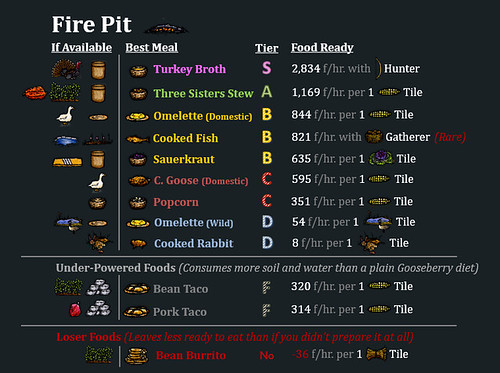
#16 Re: Main Forum » How should clothes work heat-wise? » 2019-02-12 02:30:52
Also, when coming into the house, I do not want to encourage you to "strip down" completely. That would be tedious. But I would want you to take off your hat, or your polar coat. Just one thing removed should be enough to regulate you down to perfect.
Have you considered allowing players to switch states on their clothing between "warming" and "cooling" modes? That could allow players to quickly adjust the temperature effect of clothing without the complications of losing items, hunting for ground space, or forgoing it entirely because of hot biomes.
For example:
Switching a hat slips it off so it rests behind your head
Switching a cloak (seal fur, sheep skin, etc.) rolls it into a bundle at your shoulders
Switching a coat unzips it to let cool air in
Switching a loincloth pulls out the pockets (rather than pulling off, since that would look rather silly)
Switching shoes removes and ties them at your waist
By introducing an element of player control like this, it becomes relatively easy to justify wearing full clothing since you can quickly adjust your insulation level before "going out the door" into cold biomes or "stepping inside" to warm ones again on your return. It's also quick enough to make players pause and consider how much clothing to use for a particular trip (e.g. will it be a quick run there and back? will I be visiting Desert? did I just catch Yellow Fever? etc.)
However, I think it's important to consider that the trifecta of insulated buildings, heat sources, and full clothing should be too hot when put together, rather than just approaching an ideal temperature. Otherwise, clothing will always be a static trade-off between maxing everything or doing nothing at all, which gets decided in forums (by people doing math) rather than as a gameplay feature.
#17 Re: Main Forum » How should clothes work heat-wise? » 2019-02-07 22:49:18
Here's a few suggestions to consider based on what we know about historical clothing styles (before modern industry) and real-world thermodynamics!
1. Historically, insulative cloth has had two, totally different purposes: while it's commonly used for retaining body-generated heat in cold environments, it's also almost ubiquitous for warding off solar heat in hot environments.
For real societies, that means insulative clothes have been very common both in the coldest extremes like the Artic and hottest extremes like the Sahara desert. Typically, the only fundamental difference between these styles is how readily you can adjust airflow within the garments (to encourage or discourage heat loss through sweating).
In the current simulation, player heat and tile heat are added together and then amplified by the insulation in clothing. That seems to generate rather counter-intuitive heat behavior in hot biomes or near heat sources, where insulative clothing causes you to roast instead of preventing the heat from affecting you quickly.
As a thought experiment, if you're toasting your hands by a campfire in winter: do you typically keep your mittens on or take them off to get more heat? Intuitively, taking off insulation should make you absorb the warmth faster.
2. Both historical and modern building insulation are very effective at normalizing towards a single, consistent temperature. This is primarily due to how quickly natural (or forced) airflow equalizes temperature inside.
In the current simulation, heat sources and sinks don't travel very far at all compared to real-world conditions. That's probably the main reason that building walls, functionally, isn't all that worthwhile right now despite their high insulation rating. In player usage, interior spaces larger than 3x3 tiles tend to quickly regress to the same temperatures you'd get with flooring alone since heat travel is much weaker than tile-based heat over most distances.
An interesting, alternative solution for this might be to intentionally simplify the heat calculations within buildings, effectively treating completed walls as a single temperature zone with averaged conditions across all tiles. That would allow players to treat temperature control as a new game mechanic, carefully selecting the balance of biomes underneath buildings and adding campfires (+heat) or snowmen (-heat) for fine tuning the temperature ranges indoors in a way that outdoor camps simply can't match.
3. Historical clothing styles were always designed around what was safe / effective for daily use.
With Yellow Fever currently posing a lethal threat (without assistance) if players have more than 40% insulation, it's very difficult to imagine small adjustments which could convince players to wear more than 1-2 clothing pieces. That interaction should be adjusted somehow, perhaps by allowing players to take off clothing once sick or having clothes not affect Yellow Fever penalties. It's not really safe to just avoid Jungle biomes, since Mosquito Swarms can spawn into any biome that's adjacent to a Jungle somewhere.
#18 Re: Main Forum » Update v195: Temperature of Desert Buffed, (Jungles still op) » 2019-02-07 21:31:42
A cooked rabbit is 10 pips. 6 berries in a bowl is 30 pips. So, 40 pips for a rabbit and a bowl of berries. Each bite of a berry rabbit pie is 18 pips. So, a berry rabbit pie plate is 72 pips. Even not accounting for yum, where is the pip loss?
Don't get too tangled in the math. Since crafting relies on production chains, you should always compare against the nearest one-step simpler food that can be made with the same ingredients. For example,
1 Cooked Rabbit Pie (56) + 1 Carrot (7) + 1 Bowl of Gooseberries (30) = 93 food provided
1 Cooked Rabbit Berry Carrot Pie (80) = 80 food providedSince the batch size (1 Bowl of Dough) is 4 pies, your net food is -13 x 4 = -52 food pips. As I showed earlier in the thread, you need an average of 4x Yum Chain from every player eating it to justify taking additional actions to make a RBC Pie over the one-step simpler Rabbit Pie. However, it's generally preferable to make Rabbit Carrot Pie (+36 pips) over either option, since that's a net positive crafting step regardless of Yum bonus.
I won't take up everyone's time by walking through your other examples in detail, but they do each appear to be omitting ingredients or skipping over the one-step simpler comparison for crafting purposes. If you're unsure on the details for a recipe, you can always visit OneTech to look up the correct stuff beforehand.
#19 Re: Main Forum » Update v195: Temperature of Desert Buffed, (Jungles still op) » 2019-02-07 06:14:42
Just remember to account indivdual btes, don't add yum to the bite and multiply number of bites, that doesn't work since we can't break chain.
You might be confusing the math a bit. If you're looking at Yum chains specifically, it should always be one bite per player to find how much bonus it can provide, ie. 6 meals provided means 6 players using it in different Yum chains.
Newbies usually don't know how to recognize enough foods to build >4x Yum chain, so it's best to funnel them toward the staple efficient foods: Whole Milk, Three Sisters Stew, Carved Turkey, Mutton Pie, and Rabbit Pie.
It's wrong to think one staple food is enough, though! That's easily the quickest way to create a famine since there's a single point of failure on the whole village's food supply. It's much better to have 3-4 staple foods available, minimum, so that you can reduce overcrowding in workspaces and avoid reliance on Gooseberry Bushes (which newbies wipe out completely in times of famine).
In particular, Mutton Pies are not a good sole food in any village since the Compost -> Gooseberry -> Sheep cycle takes up to 15 minutes to restore if it gets interrupted. Most other staples benefit from having raw ingredients that newbies don't know how to eat, and also won't miscook nearly as often (like the dreaded baskets of Cooked Mutton just as you go to make pie). Not to mention Mutton Pies are only the 5th-most efficient food.
#20 Re: Main Forum » Update v195: Temperature of Desert Buffed, (Jungles still op) » 2019-02-07 01:12:06
I also remain convinced there are at least a moderate amount of starvation deaths caused by people waiting til the last minute to eat to save food.
At least that's what i assume by the sheer number of people who inexplicably drop dead surrounded by food.
After teaching a lot of new players, those deaths are almost always a result of inexperience. Newbies are much more likely to have trouble recognizing food sources (e.g. "There's stew I can eat if I have a bowl"), avoiding temperature extremes (e.g. standing in a fire on Desert), or responding quickly enough when they notice the starvation pings. All of which make it pretty easy to die with food close at hand.
It's much more common to find experienced players hoarding food ahead of time in packs or hidden behind trees, and being a bit more wasteful with their food consumption in favor of time efficiency or preserving Yum chains. When famine hits a village, it often results in a higher rate of newbie deaths because experienced players are so good at guarding their food sources from others.
#21 Re: Main Forum » Update v195: Temperature of Desert Buffed, (Jungles still op) » 2019-02-07 00:30:46
But do not make any pies with berry. It is wasteful and, since all the pies look alike, it is too hard for people to tell them apart for yum purposes. It would be better to provide obvious pie alternatives, like stew or burritos, rather than six different types of identical-looking pies.
This is a good warning to share. Between all the available foods now, only 4 turn out to be "food loss" recipes for a village: Rabbit Berry Pie (-56 pips), Rabbit Berry Carrot Pie (-52 pips), Buttered Bread with Skim Milk (-28 pips), and Bean Burritos (-9 pips).
While many players approach Yum bonus with a bit of mysticism, it's actually super simple to look at the math for whether Yum will outweigh food loss on these recipes:
Minimum Yum Chain * Meals Provided - Comparative Food Loss >= 0
Generally, foods which provide multiple Yum counts (like Turkey or Potatoes) or a large number of meals make the best candidates for increasing the variety of diets in your village. But if the Yum chain requirement is especially high for any recipe (>4x), you shouldn't leave it out where newbies might consume it by accident.
So where do those 4 foods break-even with Yum?
RB Pie & RBC Pie each provide 4 meals and 1 Yum count per player, across a set of 4 pies per batch. For them to be a net food gain for the village, every person who eats one needs at least 4x Yum Chain after having already consumed a Gooseberry, a Carrot, and a Slice of Bread. That's practical for experienced players, but it can have a negative impact on your village's Compost cycle if too many are made at once.
Buttered Bread together with Skim Milk provides 2 Yum counts for 8 meals and 1 Yum count for 2 meals. For this to be a good variety addition over just Bread and Whole Milk, each person who starts eating them needs at least 1x Yum Chain beforehand. Well, that's super easy even for newbies! It also helps with teaching them to milk Cows, which is one of the best food sources in the entire game (up to ~1,600 food per Soil).
And finally, Bean Burritos provide 1 Yum count for 6 meals. For them to be a net food gain for the village over Bean Tacos, every person who eats one needs at least 10x Yum Chain after having already consumed a Bowl of Green Beans. That's going to be quite rare and puts Bean Burritos at nearly the very last in line for sources of diet variety.
#22 Re: Main Forum » What do babies want from me? » 2019-02-04 05:14:14
optimization is everything
i had a life when i quit midlife, when i told they shouldn't build and plant mid desert as its too hot, need 4x more food , she said "i like to eat"
Deserts were changed in v195, it's now only +50% food consumption in deep desert compared to Jungle or perfect desert edge.
Considering how much food you lose if newbies expand the village into cold patches (+270% food consumption) past the desert edge, you're probably much better off settling where she suggested compared to anywhere else now.
#23 Re: Main Forum » To report an extremely terrible griefer on the biggest server » 2019-02-04 02:00:17
You can make a spark gap transmitter in the entrance to avoid someone putting a door it's unremovable, doesn't block movement and only costs 4 copper pretty easy to make too
Thanks for this! I was searching through the different Radio components for which one would be simplest to craft for this purpose, and Spark Gap Transmitters certainly seem like the simplest with only a Newcomen Roller involved and no drain on your Iron supplies.
#24 Re: Main Forum » Update v195: Temperature of Desert Buffed, (Jungles still op) » 2019-02-04 01:03:50
bean burritos use up 1.5 wheat, bread 1 , pies 0.25 for 1 plate
its just a special case of having too much beans, happens often that people pick a seed accidentally, drop it, then someone plants it everywhere
Swiping a Bowl of Green beans while the plants are fresh takes a single action and produces net food (+9 pips) compared to:
1. Pulling off 6 Dry Bean Pods individually
2. Putting them each into a bowl
3. Mashing them
4. Rinsing them
5. Cooking them on hot coals
6. Making 2 Bowls of Dough
7. Forming 6 Wheat Tortillas
8. Stacking them
9. Combining it all to finish a set of Bean Burritos
I just really don't see any situation where a village would benefit from a resident Burrito Man doing all that work, when any farmer could produce more food (and equivalent Yum) without even pausing their watering routine. Not to mention that Dry Bean Pods can't decay, so there's never any pressure to "use them up" when you could produce 8 meals of Three Sisters Stew (ideally) or Bean Tacos (for Yum) with the same ingredients at some point in the future.
Since Bean Burritos already provide maximum food (19 pips) per meal, there's not really a way for Jason to make them worthwhile for a village either, without adding new art to support a larger stack size or multiple bites per burrito (like Baked Potatoes).
#25 Re: Main Forum » Update v195: Temperature of Desert Buffed, (Jungles still op) » 2019-02-03 06:24:58
Burritos are a perfectly good food. Tacos on the otherhand, never taco.
I very strongly recommend against ever making Bean Burritos. They're a net food loss (-9 pips) compared to using the same ingredients for Bread and Bowl of Green Beans, so you get nothing back for the time and effort they take to produce.
While Bean Tacos (+48 pips) and Pork Tacos (+76 pips) are modestly productive, they're pretty poor for water efficiency before Kerosene / Diesel make water wildly abundant. Better alternatives for your Green Beans and Dried Corn can be either Three Sisters Stew (+195 pips) or drawing Whole Milk from a Cow (+128 to +408 pips depending on your speed). The payback for your time with these is simply astronomical in comparison.
